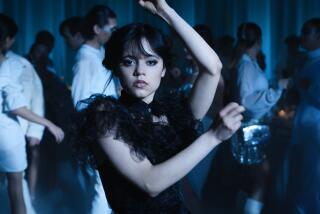TV REVIEWS : Saturday Morning Cartoons Offer Good Reason to Sleep In
- Share via
Over the past few years, Saturday morning cartoons have undergone a minor renaissance. The appearance of “The Gummi Bears,” “My Pet Monster,” “A Pup Named Scooby-Doo” and “The Adventures of Winnie the Pooh” seemed to promise a happier era of higher standards in children’s programming.
But the new shows for the 1989-90 season, which debuted on the past two Saturdays, break that promise: Parents will need a post-hole digger to find the standards used in making them. These series suggest a return to the bad old days of the ‘70s, when storytelling in cartoons vanished like the vitamins Uncle Ben supposedly sealed into rice, and “animation” meant images that were drawn, rather than images that moved.
This decline can be attributed to a number of factors: the falling value of the dollar and the concomitant rise in overseas production costs; breakneck production schedules; reduced network license fees on Saturday morning; the limits that anti-violence pressure groups have placed on slapstick comedy and dramatic conflict. But assigning blame doesn’t alter the result: American children are getting inferior entertainment.
Here’s an overview of the new Saturday morning lineup--and it seems appropriate that the same word would be used to describe this array of shows and suspected criminals.
NBC Programs
“Camp Candy.” A formula cartoon sitcom with a caricature of John Candy ineptly riding herd on a standard assortment of smart-mouth kids. There’s a snooty Valley Girl, a “cool” boy (“Dude!”), a nerdy little boy with glasses, a tomboy obviously modeled after Peppermint Patty. Although billed as a “live action/animated comedy,” there was no live action in the first episode--and precious little comedy.
“Captain N: The Game Master.” A formula cartoon adventure about Kevin, a teen-aged boy who somehow gets sucked into an animated world of computer games. Naturally he’s a whiz at Nintendo games, and uses his skills to aid beautiful Princess Lana in her battle against the evil Mother Brain, a disembodied monster whose voice sounds like a Little Richard album played at about 30 r.p.m. This premise has been used before (“TRON,” “The Last Starfighter”), but all these characters seem to do is plug the various games.
“The Karate Kid.” This cheapo adventure based on the popular films ranks as the worst new show of the season. The first episode had Daniel, Mr. Miyagi and a girl named Taki rafting down the Amazon in pursuit of a magical “shrine.” How they got to South America, where Taki came from and the source of the shrine’s powers, were never explained. A more significant puzzle is why Miyagi talks in the sort of fortune-cookie dialogue that went out with Charlie Chan movies (“Honorable gentleman is what Daniel-san call ‘real jerk’ ”). Isn’t NBC’s standards and practices department supposed to prevent racial stereotyping on children’s shows? And why did Pat Morita--who supplies the character’s voice--lend his talents to this turkey?
“ALF Tales” puts the cartoon version of Alf into various classic fairy tales. The writers seem to be trying to redo Jay Ward’s irreverent “Fractured Fairy Tales,” but the results are utterly flat. It’s also not clear that children will understand the references in some of the punch lines: “I’ll have to check the warranty on my liposuction.” No worse than a trip to the dentist without anesthetic.
CBS Programs
“Dink, the Little Dinosaur,” owes a lot to Don Bluth’s “The Land Before Time.” Both focus on cute-as-a-button baby dinosaurs of different species who learn to play together. (Their behavior is supposed to offer a subtle lesson in tolerance.) The enormous size of the dinosaurs is one of the principal reasons for their enduring popularity with children, but “Dink” robs them of that epic scale and reduces them to so many saccharine squeeze toys.
“The California Raisins.” Will Vinton’s commercials of animated clay raisins dancing to old rock songs launched a marketing phenomenon. The Raisins are so popular on toys and T-shirts, it was probably inevitable that someone would get the semi-bright idea of using them in a children’s show. The drawn animation in the series, however, fails to re-create the slick, funky motions of the clay characters. Rather than make the animators draw a lot of wrinkles, the Raisins have been redesigned with smoother bodies, which makes them look like the California Eggplants. The net result, an inane comedy about a show-biz group with a hapless manager, resembles a lame retread of the old “Alvin Show.”
Kidvid attempts to go hip in “Rude Dog and the Dweebs”: The title character and his garish canine followers are drawn in an angular, new wave style. Unfortunately, these with-it designs only look good from one or two angles and tend to fall apart when the artists try to move them. Underneath a lot of pseudo-cool gnarlyspeak (“Yo, Dudes, get rude!”) is an ordinary cartoon sitcom about a pack of talking animals living in an otherwise normal city, in the dubious tradition of “Top Cat” and “Foofur.” Yo, Dudes, get the “off” button!
The one new ABC series, the regrettable “Beetlejuice,” already has been reviewed. Despite the inclusion of “Beetlejuice” and “Slimer and the Real Ghostbusters” in its schedule, ABC offers the best Saturday morning fare: “A Pup Named Scooby-Doo,” “The Gummi Bears/Winnie the Pooh Hour” and “The Bugs Bunny and Tweety Show.”
Finally, anyone who doubts the negative impact of the former Reagan Administration’s decision to loosen the restrictions on the number of commercials shown on Saturday morning should try watching an hour of kidvid. Young viewers are deluged with ads for toys, chewing gum, sugar cereal and other over-sweetened treats. The cereals may be presented as “a part of this balanced breakfast,” but this plethora of commercials hardly constitutes balanced viewing.
More to Read
The complete guide to home viewing
Get Screen Gab for everything about the TV shows and streaming movies everyone’s talking about.
You may occasionally receive promotional content from the Los Angeles Times.






